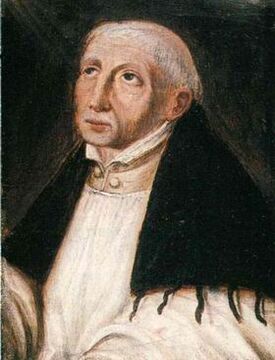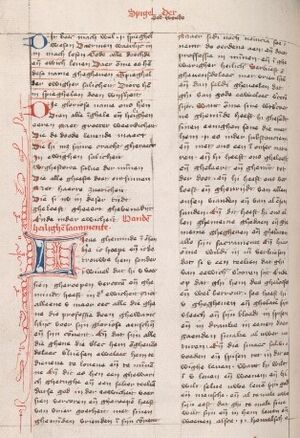John of Ruusbroec facts for kids
Quick facts for kids BlessedJohn van Ruysbroeck Can. Reg. |
|
|---|---|

The blessed John van Ruysbroeck
|
|
| Doctor Divinus Ecstaticus | |
| Born | c. 1293–4 Ruisbroek, Duchy of Brabant, Holy Roman Empire |
| Died | 2 December 1381 (aged 87–88) Groenendael, Duchy of Brabant, Holy Roman Empire |
| Venerated in | Roman Catholic Church |
| Beatified | 9 December 1908 by Pope Pius X |
| Feast | 2 December |
| Attributes | canonical habit |
|
John of Ruusbroec
|
|
|---|---|

John of Ruysbroek by Antony van der Does
|
|
| Born |
Jan van Ruysbroeck
|
|
Notable work
|
The Sparkling Stone The Spiritual Espousals |
| Era | medieval philosophy mysticism |
| Region | Western philosophy Rheno-Flemish spirituality |
|
Main interests
|
Theology, ascetic theology, mystical theology |
|
Notable ideas
|
Passion of Christ, ascetism, detachment, humility, charity, Christian universalism |
John of Ruusbroec (born around 1293 or 1294 – died December 2, 1381) was an important mystic from the Low Countries during the Middle Ages. He was an Augustinian canon, which means he was a priest who lived in a community under certain rules. He wrote many books, including The Spiritual Espousals and The Sparkling Stone. John of Ruusbroec wrote in Middle Dutch, the language spoken by ordinary people, instead of Latin. This helped more people understand his ideas.
Contents
Life Story of John of Ruusbroec
Early Years and Becoming a Priest
John of Ruusbroec had a very religious mother who raised him in the Catholic faith. We don't know anything about his father. His last name, Van Ruusbroec, comes from his hometown, Ruisbroek, near Brussels.
When he was about eleven, John left home to live with his uncle, Jan Hinckaert. His uncle was also a canon and lived a very simple, religious life in Brussels. John's uncle made sure he got a good education to become a priest. In 1318, John became a priest. His mother had moved to Brussels and joined a group of religious women called Béguines before she passed away.
Serving as a Priest in Brussels
From 1318 to 1343, John worked as a parish priest at St. Gudula's Church in Brussels. He continued to live a very strict and quiet life with his uncle and another priest, Frank van Coudenberg. During this time, a woman named Heilwige Bloemardinne was spreading ideas that John believed were wrong. She wrote popular pamphlets to share her views. John wrote his own pamphlets in Middle Dutch to explain why her ideas were incorrect. These writings are now lost. This experience made John decide to always write in the local language. He wanted to help ordinary people understand true religious teachings.
Life at Groenendaal Priory
John wanted an even quieter life, away from the city. So, in 1343, he, his uncle, and Frank van Coudenberg moved to a hermitage (a place for hermits) in the Sonian Forest near Brussels. The ruins of this monastery can still be seen today.
Many people wanted to join their small group. So, in 1349, the hermitage became an official religious community of canons regular. This community became known as Groenendaal. Frank van Coudenberg became the first provost (the head of the community), and John Ruysbroeck became the prior (the second in charge). His uncle, Jan Hinckaert, lived nearby but did not officially join because of his old age and health.
The years from 1349 until his death in 1381 were very busy and important for John. He became famous as a holy man and a wise spiritual guide. People from Flanders, Brabant, Germany, and France came to him for advice. He met with other religious groups and was visited by Geert Groote, who started the Devotio Moderna movement.
John of Ruusbroec passed away at Groenendaal on December 2, 1381, at the age of 82.
His Writings and Books
John of Ruusbroec wrote twelve books, seven letters, two hymns, and one prayer. All of them were written in Middle Dutch.
Around 1340, he wrote his most famous work, The Spiritual Espousals. Many copies of this book still exist in Dutch, Latin, and German, showing how popular it was. Parts of it were even translated into English. Around the same time, he also wrote a shorter book called The Sparkling Stone.
Most of John's well-known writings were created while he was at Groenendaal. His longest book, The Spiritual Tabernacle, was started in Brussels but finished at Groenendaal. He also wrote two short works: The Christian Faith (explaining the Creed) and The Four Temptations.
Later, he wrote four pieces for a nun named Margareta van Meerbeke. These include The Seven Enclosures, The Seven Rungs, and A Mirror of Eternal Blessedness.
Around 1363, some monks from Herne asked him questions about his first book, The Realm of Lovers. John visited them to explain his teachings more clearly. He then wrote down these explanations in his work, The Little Book of Enlightenment.
John's Ideas and Teachings
One of John's most read works is The Seven Steps of the Ladder of Spiritual Love. His most famous and important book is The Spiritual Espousals. It has three parts, talking about:
- The active life (doing good deeds)
- The inner life (thinking and feeling)
- The contemplative life (deep prayer and connection with God)
John wrote when he felt inspired. He loved to walk and meditate alone in the forest near his monastery. He often carried a small tablet to write down his thoughts. Later in life, he said he only wrote when he felt the Holy Ghost guiding him.
His writings don't form a strict system of ideas. Instead, he explains and supports traditional Christian teachings very clearly. In his books about living a good life, he often talks about:
- Detachment: Not being too attached to worldly things.
- Humility: Being humble and modest.
- Charity: Showing great love for God and others.
- Avoiding worldly distractions.
- Thinking deeply about the life of Jesus Christ, especially his suffering.
- Giving oneself completely to God's will.
- Having a strong, personal love for God.
John of Ruusbroec believed that people find God deep within their own soul. He described three steps to growing spiritually:
- The active life: Doing good deeds and helping others.
- The inward life: Focusing on your inner thoughts and feelings.
- The contemplative life: Reaching a deep, quiet union with God.
He taught that even at the highest level of spiritual growth, the soul still keeps its own identity. It doesn't completely merge with God. He wrote that we become "one in love, not in essence and nature" with God. Some people found his words a bit unusual, but many others, like Thomas à Kempis, praised his teachings. His ideas also influenced Dag Hammarskjöld, a former Secretary-General of the United Nations.
Honoring John of Ruusbroec
After John of Ruusbroec died in 1381, his relics (remains) were carefully kept, and he was honored as a saint. People called him the Ecstatic Doctor or Divine Doctor. His ideas helped connect different religious groups and may have influenced later religious changes.
When the Groenendaal Priory was closed in 1783, his relics were moved to St. Gudula's Church in Brussels. However, they were lost during the French Revolution. John of Ruusbroec was officially declared "Blessed" on December 9, 1908, by Pope Pius X.
There are no real pictures of John of Ruusbroec from his lifetime. But traditional paintings show him in his religious clothes, sitting in the forest with his writing tablet. This comes from a story that his fellow monks once found him in a deep spiritual state, surrounded by flames that didn't burn him or the tree he was under.
Today, there is a Ruusbroec Institute at the University of Antwerp that studies the history of spirituality. There is also a school named Jan van Ruusbroeckollege in Laken, Belgium.
See also
 In Spanish: Jan van Ruusbroec para niños
In Spanish: Jan van Ruusbroec para niños
- List of Latin nicknames of the Middle Ages: Doctors in theology
- Evelyn Underhill's Ruysbroeck


